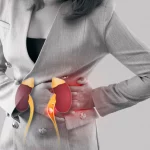Cystic Fibrosis Symptoms
Cystic fibrosis is a chronic, progressive disease that affects the lungs and digestive system. A main cystic fibrosis syndrome symptom is a persistent cough with mucus production. Other symptoms include shortness of breath, wheezing, frequent respiratory infections, poor growth, and diarrhea. There is no cure for cystic fibrosis, but treatment can help control the symptoms and extend life expectancy. Treatment typically involves a combination of medication, physiotherapy, and a special diet.

Cystic Fibrosis Causes and Risk Factors
The disease happens due to a mutation in the Cystic Fibrosis Transmembrane Conductance Regulator (CFTR) gene. This gene provides instructions for making a protein essential for salt and water balance in cells. Mutations in the CFTR gene lead to the production of an abnormal CFTR protein that does not function properly.
There are over 1,700 mutations of the CFTR gene, divided into six classes based on their effect on the CFTR protein.
Cystic fibrosis is an autosomal recessive disorder, which means that a person must inherit two defective copies of the CFTR gene – one from each parent – to have the disease. If a person inherits only one bad copy of the gene, they will be a carrier but will not show any symptoms.
When both parents are carriers of a defective CFTR gene, there is a 25% chance with each pregnancy that their child will inherit two regular copies of the gene, a 50% chance that the child will inherit one normal copy and one defective copy (and be a carrier), and a 25% chance that the child will inherit two faulty copies of the gene (and have Cystic Fibrosis).
While cystic fibrosis gets diagnosed in childhood, adults can also be diagnosed with the condition. Approximately 10% of people with cystic fibrosis are over 18 when they receive a diagnosis. The average cystic fibrosis life expectancy has increased in recent years and is approximately 37 years. However, life expectancy varies depending on the individual and the severity of their condition.
Several risk factors can affect an individual’s chance of developing the disease or having a child with cystic fibrosis. These include:
– Ethnic background: As mentioned above, certain ethnic groups are more likely to be carriers of the defective CFTR gene. These groups have Ashkenazi Jews, with a rate of 1 in 17. Other high-risk groups include Caucasians of Northern European descent, Hispanics, and African Americans.
– Family history: If you have a family member suffering from the illness, you may be at an increased risk of being a carrier of the defective CFTR gene.
– Male gender: It is more common in males than females, which may be because the symptoms are often more severe in males.
– Smoking: Smoking can worsen the symptoms, and is therefore not recommended for people with the condition.
– Age: The disease is most commonly diagnosed in children, but adults can also be affected by the condition.
– Obesity: People with the illness are more likely to be obese than the general population, which may be due to the increased energy expenditure associated with Cystic Fibrosis.
– Diabetes: People with the disease are at an increased risk of developing diabetes.
– Asthma: People with cystic fibrosis are more likely to have asthma.
Cystic Fibrosis Treatment
There is no cure for the disease, but treatments are available to help manage the symptoms and improve the quality of life for people with the condition. These treatments include:

– Pulmonary rehabilitation: This is a type of exercise program that can help to improve the function of the lungs.
– Cystic Fibrosis transmembrane conductance regulator (TR) modulators: These drugs help improve the CFTR protein’s function. They are currently only approved for use in people with certain types of cystic fibrosis mutations.
– Antibiotics: Antibiotics treat lung infections in people with the disease.
– Bronchodilators CFTR protein: These drugs help to widen the airways and make it easier to breathe.
– Inhaled medications: These drugs can help reduce the inflammation in the lungs.
– Oxygen therapy: This type of treatment involves breathing in pure oxygen. It can help to improve the function of the lungs and reduce its symptoms.
– Surgery: In some cases, surgery may treat the disease.



